Rochagem Congress Part 4: ‘Rocks for Crops’ in the World
Peter van Straaten and the Rocks for Crops multi-cultural collaboration with Lombok University, Indonesia.
Dr. Peter van Straaten spoke at the III Brazilian Rochagem Congress in November 2016 (which we have previously featured in a series of articles: Part 1, Part 2, and Part 3). In his presentation, which was based on the article reprinted below, he challenged the audience to not only include geologists, soil scientists and agronomists in agrogeological research and development but also include farmers as equal stakeholders. Farmers are important as they can direct our efforts to a practical and sustainable ‘down to earth’ approach, so we need to include them more in our efforts. A striking example of this is Dr. Suzi Huff Theodoro’s work with the quilombolas in Bahia (which is presented in this video). We need to consider the complexity of biological and chemical systems. We need to consider rock types in relation to the microbial life. We need to consider remineralization for forestry as well as agriculture.
–V. Miranda Chase
Introduction
Good quality, healthy soils and available water are two important natural resources that support life on Earth. Rocks are the parents to soils. Parent materials, consolidated or unconsolidated rock materials, are transformed to soils by physical, chemical and biological weathering processes whereby weathering is most intensive in tropical regions of the world. In natural systems and long-term time frames, geological processes, such as mountain building, erosion and sedimentation, as well as volcanism are fundamental agents of soil formation and soil rejuvenation.
In order to meet the increasing food requirements for increasing populations on Earth various strategies have been employed to replenish soil nutrients for increased crop production. Mimicking natural processes by physically, chemically and biologically accelerating nutrient release from ‘fertile’ rock and mineral phases is seen as pragmatic and inexpensive option to contribute to soil fertility management, especially in the tropics (Leonardos et al. 1987, 2000; Fyfe et al. 2006; Theodoro and Leonardos 2006, Chesworth et al. 1985; van Straaten 2002, 2006).
Agrogeology and ‘rocks for crops’
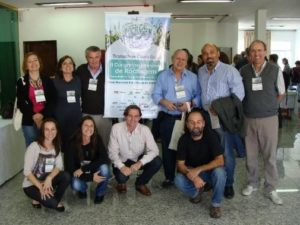
Brazil – The epicenter of Rocks for Crops research and development. This photo is from the III Rochagem Congress in Pelotas, Rio Grande del Sol. (Click to enlarge)
The term agrogeology, as used in this presentation introduces a branch of geology that focuses on the distribution and correlation between soil fertility and bedrock materials, and studies related to geological rejuvenation of soils, and secondly, to research and development of agromineral resources and agromineral modification techniques that can be beneficial to enhance and maintain the chemical, physical and biological productivity of soils for the benefits of a sustainable agricultural system. The term ‘rocks for crops’ that addresses the latter aspect of agrogeology was used for the first time by van Straaten (2002).
The parent material – soil relationship aspect of agrogeology has been studied for decades, in many countries and by many soil scientists. In China, the so-called agrogeological surveys are in fact geochemical surveys encompassing the relationship between geology, soil fertility and soil contamination with heavy metals (Liao et al. 2007). For example, the systematic regional geochemical survey in Jiangsu Province in China involved systematic sampling of soil surface and subsurface at densities of 1 sample per 4 km2, analysed for 52 elements. In other countries, the relationship of parent material to soil and the distribution of soils in relation to parent material has been conducted either on the basis of mapping or specific studies at selected sites.
In Brazil, Marques et al. (2004) and Curi and Franzmeier (1987) demonstrated that the major element geochemistry and mineralogy in Brazil’s Cerrado soils widely reflect the underlying geology. These scientists showed that soils developed on basaltic material have the highest clay content, highest CEC, P, Ca, Fe, Ti concentrations, as well as the highest levels of organic C, in contrast to soils developed on sediments and metamorphic rocks. They also showed that micronutrients concentrations can be used in deeply weathered Latosols of Brazil to identify the underlying parent materials. Micronutrient concentrations in mafic-rock derived soils show a strong correlation with parent materials (Campos et al. 2003). Some recent work in Pernambuco State, NE Brazil have shown that soils overlying different granite types exhibit different soil fertilities (Silva et al. 2016, 2017).
In Brazil and Australia and other countries modern remote sensing techniques and geophysical methods have been successfully employed to map soils in relation to the underlying geology (Wilford et al. 1997; van Straaten (2015) and van Straaten et al. (in prep.). Airborne and ground geophysical methods applied alongside geological and soil investigations are continuing in Pernambuco state (van Straaten in prep.).
The use of rocks for crops to improve soil fertility has a long history, spanning from the Egyptians, Greeks and Romans who knew the value of certain rocks to increase crop production to the founding fathers of modern agricultural chemistry, Sir J. B. Lawes (1814-1900), and Justus von Liebig (1803-1873), who were instrumental in the production of the first commercial superphosphate and K fertilizers. In contrast to using only one principal nutrient from rocks, Hensel (1890, 1894) used finely ground whole rocks as low-cost, locally available geological multi-nutrient resources for agricultural development. Research on the use of multi-nutrient geological resources as soil amendments and rock fertilizers was re-kindled by Keller (1948), Keller et al. (1963), Fyfe et al. (1983) Chesworth et al. (1983, 1985), Fyfe (1989), Fyfe et al. (2006) and van Straaten (1984, 2002, 2006, 2007).
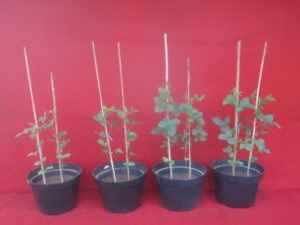
From left to right: Leucite bearing volcanic rocks in East Java; thin section of volcanic rock with leucite; soybean trial with leucite bearing volcanic rock, 49 days after planting (source: Sayekti 2015). (Click to enlarge)
In the 1870s and 1880s the term agrogeology was widely used in Germany, as a term for soil science. Scientists stressed the importance of rock weathering for soil forming processes and agrogeology was considered a branch of geology (Yaalon 1997; Simonson 1999). The concept of soil science changed however when the famous Russian soil scientist Dokuchaev (1846-1903) advanced the knowledge of processes of soil formation that not only involved rock and mineral weathering but the complex interactions and interrelationships between rocks, organic matter, climate and vegetation and biophysical and chemical processes. Following the Russian soil scientists, soil schools in other parts of Europe and the United States created the new science of ‘pedology’.
The first two International ‘Agrogeology’ conferences were held in Budapest (1909) and Stockholm (1910) but the name changed to ‘agropedology’ in 1922. Two years later in Rome, the concept – and name – had evolved into pedolology and consequently the conference was called the Fourth International Pedological Conference (Simonson 1999). Thereafter the term agrogeology was not used in soil science conferences for the next decades.
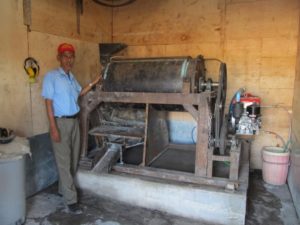
Innovative modification of volcanic rock for application in rice fields in Sumbawa Island, Indonesia (Prof. Joko Priyono). Shown here: a local grinding mill. (Click to enlarge)
In the 1980’s, the concept and name ‘agrogeology’, and especially the aspects of ‘rocks for crops’ was taken up again by scientists from the United States (Keller 1948, Keller et al. 1963) and Brazil (Leonardos et al. , 1987; 2000), and Canada (Chesworth et al. (1983, 1985), Fyfe et al. (1983), van Straaten (1984), Fyfe (1989), and van Straaten (2002, 2006, 2007). This led to the establishment of the inter-disciplinary, problem solving earth and agricultural science, agrogeology, with emphasis on the applied side of agrogeology, ‘rocks for crops’. This specific aspect of agrogeology seeks to contribute to increased soil health, food production and food security of farmers and society as a whole (van Straaten 2002). The inter-disciplinary ‘rocks for crops’ approach integrates the knowledge of researchers and practitioners from soil science, geology, engineering and rural extension services. It aims at finding practical solutions to reduce soil nutrient depletion and soil degradation.
Unfortunately, many of the stakeholders, including soil scientists and geologists commonly speak different scientific languages, occupy different buildings and work in different government ministries. Regrettably, these barriers make direct communication and interdisciplinary problem solving research and development difficult. Lack of communication and lack of funding are largely responsible that only few international, science-based ‘rocks for crops’ research and development projects have been conducted in the field so far.
‘Rocks for Crops’ research and development in the world
International experiences of ‘rocks for crops’ research and development are patchy. In some countries, like in Brazil, major efforts are made to study the use of rocks for crops, in other countries only few scientists have had the chance and funding support to study the use of agromineral resources for local agricultural developments.
In the past, most ‘rocks for crops’ studies focused on the use and modification of single nutrient component soil amendments and fertilizers, e.g. phosphate rocks and potassium-silicate and Ca and Mg sources. Research and development of these single-nutrient amendments and fertilizers will not be covered here however. Instead, I will report on R&D efforts to modify multi-nutrient silicate resources and their use in the world, in Portuguese known as ‘Rochagem’.
Research on the use of multi-nutrient bearing rock silicates requires the understanding of rock and mineral solubilities and the kinetics of the breakdown of minerals and rocks. Fundamental studies by Lasaga (1984), Brantley (2008), Brantley and Stillings (1994), Brantley and Chen (1995), Brantley and Olsen (2014), as well as Harley and Gilkes (2000), Palandri and Kharaka (2004), White and Brantley (1995, 2002) and others provide insight into the kinetics of mineral dissolution, mineral solubilities, and mineralogical and chemical aspects of weathering. These studies were primarily conducted in clean laboratory settings which are different from field conditions (White and Brantley 2003).
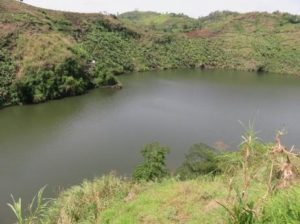
Lake Katunga (near local source of the rock dust katungite) in the Bunyaruguru area of Western Uganda. (Click to enlarge)
Research on the use of rocks for crops however not only requires knowledge of the rocks and minerals that are to be applied but also knowledge of physical, chemical and biological characteristics of the soils into which these ground mineral resources are added. And, last but not least, research and development need the knowledge of crop science, knowledge of specific plant requirements, e.g. specific nutrient requirements of food crops like rice, banana, maize. The practical application of the rock-soil-crop sequential transformation was summarized under the topic ‘Which rocks for which crops?’ by van Straaten (2013) during the Second Brazilian Rochagem Congress in Poços de Caldas, Minas Gerais, Brazil.
Review of selected multi-nutrient silicate rock research and development work worldwide
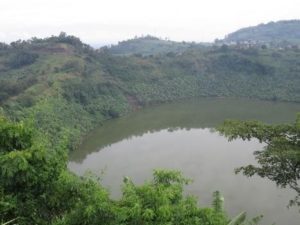
Lake Mafuro (near local source of rock dust mafurite), also in the Bunyaruguru area of Western Uganda. (Click to enlarge)
In the following short review I will provide some information on ‘rocks for crops’ research in five continents. The survey is not exhaustive as many research data and field trials are not reported in international publication. The survey is based on personal contacts and literature searches.
Multi-nutrient silicate rock research and development (R&D) work in Asia is reported from India (microbial mica dissolution e.g. Basak and Biswas (2009), Biswas et al. (2009) and silicon research for rice (Prakash et al. 2011; 2016). In Indonesia, whole rock K-silicate research has been conducted by scientists from the Geological Survey and Tekmira/Bandung, specifically on the use of K-rich leucite bearing volcanic rocks in Eastern Java (Kusdarto (2012), Wahyudi and Wahyudi (2013); Sayekti (2015). Research on the use of ‘rocks for crops’ specifically the use of Si releasing volcanic rocks for rice crops as well as innovative processing techniques such as micronizing techniques (Priyono 2005; Priyono and Gilkes 2004), and innovative rocks-to-liquid processing techniques for application on rice are being developed by Prof. Joko Priyono, Lombok University (Priyono, pers. comm.).
In sub-Saharan Africa field research on the use of whole rock silicate fertilizers is conducted in a few countries. In Cameroon the research centres on the use of various volcanic and igneous rocks on acid nutrient depleted soils (Tchouankoue et al. 2010, 2015, Tetsopgang et al. 2015, Tetchou 2012). In Malawi geological research focuses on K-bearing rocks, (nepheline syenite) by Mr. Chiwona (Chiwona et al. 2016). In Uganda, the research emphasis is currently on the use of ultrapotassic whole rocks of the ‘kamafugite’ group of rocks for use on banana and coffee crops, as well on vermiculite processing and blending of expanded vermiculite with organic sources, e.g. Tithonia diversifolia (Wanda, pers. comm. 2016).
Research in Europe is conducted in several countries, including the United Kingdom (K-processing research: Manning 2010); UK/USA: K-feldspar research, Ciceri et al. (2015); Sweden/UK: whole rock volcanic dust research (Ramezanian et al. 2013 ); the Netherlands: use of rock dust for restoration of nature reserves, Bergsma (pers. comm.); Norway: whole rock and K-rock research and development, trace element concerns (Myrvang et al. 2016) and mitigation, tailings and composting research (Heim 2016, Bakken et al. 1997, 2000, ), mechanical activation of rock flower fertilizer (Kleiv and Thornhill 2007). In France research on microbial dissolution of phosphate rock and other agrominerals is ongoing, e.g. Hinsinger et al. (2001).
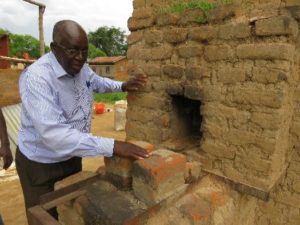
Nathan Wanda creating a blended organic-mineral product for bananas and coffee in Uganda. (Click to enlarge)
Research in South America is primarily conducted in Brazil: This is the world’s ‘epicentre’ for whole rock silicate research. Innovative research and development on finely ground multi-nutrient rock fertilizers is carried out in many parts of the country, mainly using various volcanic rocks, e.g. basalt, but also phonolite, and alkaline rock suites, as well as on zeolite application, mineral separation techniques etc. Part of the results of Brazilian researchers is compiled in the Proceedings of the First and Second Brazilian Congress of ‘Rochagem’, as well as in various national and international journals.
Outlook
There is a considerable potential for using low grade and non-conventional nutrient-bearing rock and mineral resources to increase soil fertility and thus contribute to increased global crop production to feed more people from the existing agricultural land base. Concerted multi-disciplinary efforts of all stakeholders, farmers, mineralogists, geologists, soil scientists, processing engineers and others are needed to overcome the principal barriers of slow nutrient release from rocks and minerals, and to make meaningful and practical contributions to sustainable agricultural practices.
Using direct application of crushed rocks and minerals on tropical soils have shown variable results due to the variability of chemical and mineralogical composition of rocks, variability of soils, and crop specific factors. The principal barriers for increased use of multi-nutrient silicate soil amendments and fertilizers include low mineral solubilities and high application rates (commonly > 10 t ha-1) which reduce the practicality and economics of application.
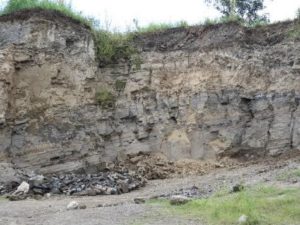
This quarry in Uganda is a source of rock dust and minerals for growing bananas and coffee. (Click to enlarge)
To improve the efficacy of nutrient release from rocks and minerals extra steps are required using microbiological, chemical and physical modification techniques. Part of alternative strategies to overcome the slow release of nutrient elements from rocks and minerals is by mimicking chemical, physical and biological processes of rock and mineral breakdown. Research has demonstrated that certain modification techniques can enhance the nutrient release of some of the agromineral resources. For example, mineral solubilizing organic acids that are commonly exuded from roots or from microorganism, or mechanical activation techniques (Priyono and Gilkes 2004, Kleiv and Thornhill 2007), or thermal and hydrothermal treatment of rocks (e.g. Ciceri and Allanore 2015) have shown promises. Soil and plant induced biochemical weathering, bioweathering, of multi-nutrient silicate rocks is part of microbiological modification techniques (Berthelin and Leyval 1982; Berthelin et al. 1991; Hinsinger et al. 1993, Hinsinger 1998; Hinsinger et al. 2001) which have some potential as is the use of low molecular weight organic acids in the dissolution of minerals.
Research on the microbial or plant root induced dissolution of silicate minerals is so far confined mainly to laboratory studies. However, in India, South Korea and China, several field studies with waste mica has shown the potential of using mineral wastes to be transformed to agricultural wealth (‘from waste to wealth’). Thus, combined biological-biochemical and physical modification techniques, e.g. ‘composting with rocks’ should be studied increasingly in laboratory and field experiments. In addition, advanced and innovative methods to micronize and physically transform ground rocks into pellets – and into liquid form – need to be further developed to make progress to ‘turn rocks into crops’.
Dr. Peter van Straaten is Professor Emeritus at the University of Guelph. He is an expert in agrogeology, which he defines as “geology in service of agriculture.” He has built an international network of projects that study remineralization and sustainable agriculture in Africa. In particular, he has worked to identify important African sources of minerals for remineralization. He has helped to prove that turning rocks into fertilizer can be socially and economically viable. His work has helped lift many small farmers out of poverty in Africa and his research has recently expanded to Indonesia, Cuba and Brazil. He has written two books on agrogeology: Rocks for Crops – Agrominerals of Sub-Saharan Africa, and Agrogeology: The Use of Rocks for Crops.
References
- Bakken AK, Gautneb H, Sveistrup T and Myhr K 2000. Crushed rocks and mine tailings applied as K fertilizers on grassland. Nutr. Cycl. Agroecosyst. 56:53-57.
- Bakken AK, Gautneb H, and Myhr K 1997. The potential of crushed rocks and mine tailings as slow-releasing K fertilizers assessed by intensive cropping of Italian ryegrass in different soil types. Nutr. Cycl. Agroecosyst. 47:41-48.
- Basak BB and Biswas DR 2009. Influence of potassium solubilizing microorganism (Bacillus mucilaginosus) and waste mica on potassium uptake dynamics by sudan grass (Sorghum vulgare Pers.) grown under two Alfisols. Plant Soil 317:235-255.
- Berthelin J, Leyval C, Laheurte F and de Giudici P 1991. Involvement of roots and rhizosphere microflora in the chemical weathering of soil minerals. In: Atkinson D (editor) Plant root growth – An ecological perspective. British Ecol. Soc., Blackwell Scientific Publ. pp. 187-200.
- Berthelin J and Leyval C 1982. Ability of symbiotic and nonsymbiotic rhizospheric microflora of maize (Zea mays) to weather micas and to promote plant growth and plant nutrition. Plant Soil 68:369-377.
- Biswas DR, Naranyanasamy G, Datta SC, Singh G, Begum M, Maiti D, Mishra A, and Basak BB 2009. Changes in nutrient status during preparation of enriched organomineral fertilizers using rice straw, low-grade rock phosphate, waste mica, and phosphate solubilizing microorganism. Commun. Soil Sci. Plant Anal. 40:2285-2307.
- Brantley SL 2008. Kinetics of Mineral Dissolution. In: Brantley SL, Kubicki JD, and White AF (eds.) Kinetics of water-rock interaction, Springer New York. pp. 151-210
- Brantley SL and Olsen AA 2014. Reaction kinetics of primary rock-forming minerals under ambient conditions. In: Holland HD and Turekian KK (eds.) Treatise on geochemistry (2nd edition). Elsevier, Oxford, pp. 69-113.
- Brantley SL and Chen Y 1995. Chemical weathering rates of pyroxenes and amphiboles. In: White AF and Brantley SL (eds.) Chemical weathering rates of silicate minerals. Min. Soc. Am., Washington, D.C. pp. 119-172.
- Brantley SL and Stillings L 1994. An integrated model for feldspar dissolution under acid conditions. Mineral. Mag. 58A, 117-118.
- Campos ML, Pierangeli MAP, Guilherme LRG, Marques JJ and Curi N 2003. Baseline concentration of heavy metals in Brazilian latosols. Comm. Soil Sci. Plant Anal. 34:547-557.
- Chesworth W 1982. Late Cenozoic geology and the second oldest profession. Geoscience Canada 9:54-61.
- Chesworth W, Magias-Vasquez F, Acquaye D and Thomson E 1983. Agricultural alchemy: stones into bread. Episodes 1:3-7.
- Chesworth W, van Straaten P, Semoka J and Mchihiyo E 1985. Agrogeology in Tanzania. Episodes 8:257-258.
- Chiwona AG, Gaulton R, and Manning DAC 2016. Novel potash fertilisers for Africa’s agricultural growth. Presentation 35th Int. Geol. Congress Cape Town, South Africa.
- Ciceri D and Allanore A 2015. Microfluidic leaching of soil minerals: release of K+ from K Feldspar. Plos One. DOI: 10.1371/journal.pone.0139979, 10p.
- Ciceri D, Manning DA, and Allanore A 2015. Historical and technical developments of potassium resources. Sci. Tot. Envir. 502:590–601. DOI: 10.1016/j.scitotenv.2014.09.013
- Curi N and Franzmeier DP 1987. Effect of parent rocks on chemical and mineralogical properties of some Oxisols in Brazil. Soil Sci. Soc. Am. J. 51:153-158.
- Fyfe WS 1989. Soil and global change. Episodes 12:249-254.
- Fyfe WS, Leonardos OH, and Theodoro SH 2006. Sustainable farming with native rocks: the transition without revolution. Ann. Acad. Bras. Ciênc. 78:715-720.
- Fyfe WS, Kronberg BI, Leonardos OH and Olorunfemi N 1983. Global tectonics and agriculture: a geochemical perspective. Agr. Ecosyst. Env. 9:383-399.
- Harley AD and Gilkes RJ. 2000 Factors influencing the release of plant nutrients from silicate rock powders: a geochemical overview. Nutr Cycl Agroecosyst. 56:11-36.
- Heim M 2016. Multi-purpose application of silicate tailings in agriculture. Poster presented at GeoNor, Mo i Rana, Norway, 15-17.03.2016.
- Hensel J 1890. Das Leben. (in German) Verlag Boericke und Tafel, Leipzig, Germany.
- Hensel J 1894. Bread from stones. AJ Tafel (editor) Philadelphia, USA.
- Hinsinger P 1998. How do plant roots acquire mineral nutrients? Chemical processes involved in the rhizosphere. Adv. Agr. 64:225-265.
- Hinsinger P, Barros ONF, Benedetti MF, Noack Y and Callot G 2001. Plant-induced weathering of a basaltic rock: Experimental evidence. Geochim Cosmochim. Acta 65:137-152.
- Hinsinger P and Jaillard B 1993. Root-induced release of interlayer potassium and vermiculization of phlogopite as related to potassium depletion in the rhizosphere of ryegrass. J. Soil Sci. 44:525-534.
- Hinsinger P, Elsass F, Jaillard B and Robert M 1993. Root-induced irreversible transformation of a trioctahedral mica in the rhizosphere of rape. J. Soil Sci. 44:535-545.
- Keller WD 1948. Native rocks and minerals as fertilizers. Sci. Monthly 66:122-130.
- Keller WD, Balgord WD and Reesman AL 1963. Dissolved products of artificially pulverized silicate minerals and rocks. J. Sediment. Petrol. 33:191-204
- Keller WD and Reesman AL 1963. Glacial milks and their laboratory–simulated counterparts. Geol. Soc. Am. Bull. 74:61-76.
- Kusdarto A 2012. Rock potential resources for K-fertilizer from Ringgit Beser Complex area, Situbondo Regency, East Java Province, Indonesia. Unpubl. Rep., 7p.
- Lasaga AC 1984. Chemical kinetics of water-rock interactions. Journal of Geophysical Research B 89, B6, 4009-4025.
- Leonardos OH, Fyfe WS and Kronberg BI 1987. The use of ground rocks in laterite systems: an improvement to the use of conventional soluble fertilizers? Chem Geol 60:361-370.
- Leonardos OH, Theodoro SH and Assad ML 2000. Remineralization for sustainable agriculture: A tropical perspective from a Brazilian viewpoint. Nutr. Cycling Agroecosyst. 56:3-9.
- Liao Q-L, Evans LJ, Gu X, Fan DF, Yin Y, and Wang H 2007. A regional geochemical survey of soils in Jiangsu Province, China: preliminary assessment of soil fertility and soil contamination. Geoderma 142:18-28.
- Manning DA 2010. Mineral sources of potassium for plant nutrition. A review. Agron. Sustain. Dev. 30:281–294.
- Manning DA 2015. How will minerals feed the world in 2050? Proc. Geol. Ass. 126:14–17.
- Marques JJ, Schulze DG, Curi N and Mertzman SA 2004. Major element geochemistry and geomorphic relationships in Brazilian Cerrado soils. Geoderma 119:179-195.
- Myrvang MB , Hillersoy MH, Heim M, Bleken MA, and Gjengdal E 2016. Uptake of macro nutrients, barium and strontium by vegetation from mineral soils on carbonatite and pyroxenite bedrock at the Lillebukt alkaline complex on Sternoy, Northern Norway. J. Plant Nutr. Soil Sci. DOI:10.1002/jpln.201600328, 12p.
- Palandri JL and Kharaka YK 2004. A compilation of rate parameters of water-mineral interaction kinetics for application to geochemical modeling. US Geol. Survey Open File Rep. 2004-1068, 64p.
- Prakash NB, Anitha MS, and Sanhya K 2016. Behaviour of different levels and grades of diatomite as silicon source in acidic and alkaline soils. Silicon. DOI 10.1007/s12633-015-9373-9, p1-9.
- Prakash NB, Chandrachekar N, Mahendra C, Patel SU, Thippeshappa GN, and Laane HM 2011. Effect of soluble silicic acid on growth and yield parameters in wetland rice in hilly and coastal zone soils of Karnataka, South India. J. Plant Nutr. 34:1883-1893.
- Priyono J 2005. Effects of high energy milling on the performance of silicate rock fertilizers. Ph.D. Thesis, The University of Western Australia.
- Priyono J and Gilkes RJ 2004. Dissolution of milled-silicate rock fertilisers in the soil. Austr. J. Soil Res. 42:441-448.
- Priyono J 2014, pers. comm.
- Ramezanian A, Dahlin SA, Campbell CD, Hillier S, Mannerstedt-Fogelfors B, and Öborn I 2013. Addition of a volcanic rockdust to soils has no observable effects on plant yield and nutrient status or on soil microbial activity. Plant Soil 367:419–436
- Robert M and Berthelin J 1986. Interactions of soil minerals with natural organics and microbes. Role of biological and biochemical factors in soil mineral weathering. Soil Sci. Soc. Am. Spec. Publ. 17:453-495.
- Sayekti B 2015 (in Indonesian). Batuan vulkanik kaya Kalium untuk agromineral di Daerah Ngabinan dan Gebangan, Kabupaten Situbondo, Provinsi Jawa Timur, M.Sc. Thesis University of Padjadjavan, Indonesia. 72p.
- Silva YJAB, Nascimento C, van Straaten P and Da Silva YJAB 2017. Effect of I- and S-type granite parent material mineralogy and geochemistry on soil fertility. A multivariate statistical and GIS-based approach. Catena 149:64-72.
- Silva YJAB, Nascimento CWA, Biondi CM, van Straaten P, Souza VS, and Fereira TO 2016. Weathering rates and carbon storage along a climosequence of soils developed from contrasting granites in northeast Brazil. Geoderma 284:1-12.
- Simonson RW 1999. Origin and acceptance of the term pedology. Soil Sci. Soc. Am. J. 63:4-10.
- Stamford NP, Lima RA, Santos CRS and Dias SHL 2006. Rock biofertilizers with Acidithiobacillus on sugarcane yield and uptake in a Brazilian soil. Geomicrobiol J 23:261-265.
- Tchouankoue JP, Nkouathio DG and Njofang C 2010. Use of pyroclastic rocks from the Cameroon Volcanic Line as rocks fertilizers: preliminary results, Anais Primero Congresso Brasileiro de Rochagem, Souza Martin E. and Huff Theodoro S., Eds., pp. 31-36.
- Tchouankoue, JP, Tetchou Tchekambou AN, Abossolo, MA, Ngansop C, and Theodoro SH 2015. Rock Fertilizers as an Alternative to Conventional Fertilizers: the Use of Basalt From the Cameroon Volcanic Line for maize farming on Ferrallitic soils. In: Goreau T, Larson R, and Campe J (eds.) Geotherapy: Innovative Methods of Soil Fertility Restoration, Carbon Sequestration, and Reversing CO2 Increase, CRC Press, Boca Raton, Florida, USA, pp. 449-464.
- Tetchou Tchekambou AN 2012. Étude pétrographique et géochimique de quelques basaltes du Cameroun et essais en champ de leurs poudres comme engrais dans la culture du maïs a Akak-Yaoundé. MSc. thesis, Université de Yaoundé 1, 58p.
- Tesopgang S, Kamga P, Achoumele PFG, Alemanji B, Manjo DZ, and Mazoh L 2015. Effect of powders of baslats, tuff, granites and pyroclastic materials on the yield and quality of carrots and cabbagees grown on tropical soils in the northwest region of Cameroon. In: Goreau T, Larson R, and Campe J (eds.) Geotherapy: Innovative Methods of Soil Fertility Restoration, Carbon Sequestration, and Reversing CO2 Increase, CRC Press, Boca Raton, Florida, USA, pp. 435-443.
- Theodoro SH and Leonardos OH 2006. The use of rocks to improve family agriculture in Brazil. Ann. Acad. Bras. Ciênc. 78:721-730.
- van Straaten P 2015. The role of geophysics in agrogeology. Presentation at KEGS meeting, University of Toronto, Canada, February 10th, 2015. www.youtube.com/watch?v=yBcNDCEJBLc
- van Straaten P 2013. Which rocks for which crops? Ecophysiological and geological factors. Proceed. II Congresso Brasil. Rochagem, Poços de Caldas, Minas Gerais, pp.49-55.
- van Straaten P 2011. The geological basis of farming in Africa. In: Bationo et al. (eds). Innovations as key to the green revolution in Africa, Springer Science + Business Media BV. pp. 31-47.
- van Straaten P 2007. Agrogeology – the use of rocks for crops. Enviroquest, Cambridge, Canada, 440p.
- van Straaten P 2006. Farming with rocks and minerals: Challenges and opportunities. Ann. Acad. Bras. Ciênc. 78:731-747.
- van Straaten P 2005. Minerales en la Agricultura. In: Nielson H and R Sarudiansky (eds.) Minerales para la agricultura en Latinoamérica. CEP, Buenos Aires, Argentina, pp. 20-36 (in Spanish).
- van Straaten P 2002. Rocks for crops: Agrominerals of sub-Saharan Africa. ICRAF, Nairobi, Kenya, 338p.
- van Straaten P 1984. Agro-geological research in Tanzania. Presentation at Symposium of Geological Society of Tanzani, Feb. 1984, Dodoma, Tanzania, 10p.
- Von Fragstein P, Pertl W and Vogtmann H 1988. Verwitterungsverhalten silikatischer Gesteinsmehle unter Laborbedingungen (in German). Z. Pflanzenern. Bodenk. 151:141-146.
- Wahyudi A and Wahyudi T 2013. A literature study of benefiting K-bearing silicate rocks as raw materials for potassium fertilizer. Indon. Mining J. 16:101-110.
- Wanda NW 2015, pers. comm.
- Wilford JR, Bierwirth PN, and Craig MA 1997. Application of airborne gamma-ray spectrometry in soil/regolith mapping and applied geomorphology. AGSO Journal of Australian Geology & Geophysics, 17:201-216.
- White AF and Brantley SL 1995. Chemical weathering rates of silicate minerals: An overview. In: White AFand Brantley SL, eds.) Chemical Weathering Rates of Silicate Minerals, Vol. 31, Mineralogical Society of America, pp. 1–22.
- White AF and Brantley SL 2003. The effect of time on the weathering of silicate minerals: Why do weathering rates differ in the laboratory and field? Chemical Geology 202:479–506.
- Yaalon DH. 1997. History of soil science in context: international perspective. In: Yaalon DH and Berkowics S (eds.) History of soil science – International perspectives. Advances in Geoecology 29, Reiskirchen, Germany, pp. 1-13.
Support us on Patreon
Thank you for joining us today! Please become a member of RTE and support us on Patreon. Unlike many larger organizations, we work with a team of determined and passionate volunteers to get our message out. We aim to continue to increase the awareness of remineralization to initiate projects across the globe that remineralize soils, grow nutrient dense food, regenerate our forests’ and stabilize the climate – with your help! If you can, please support us on a monthly basis from just $2, rest assured that you are making a big impact every single month in support of our mission. Thank you!

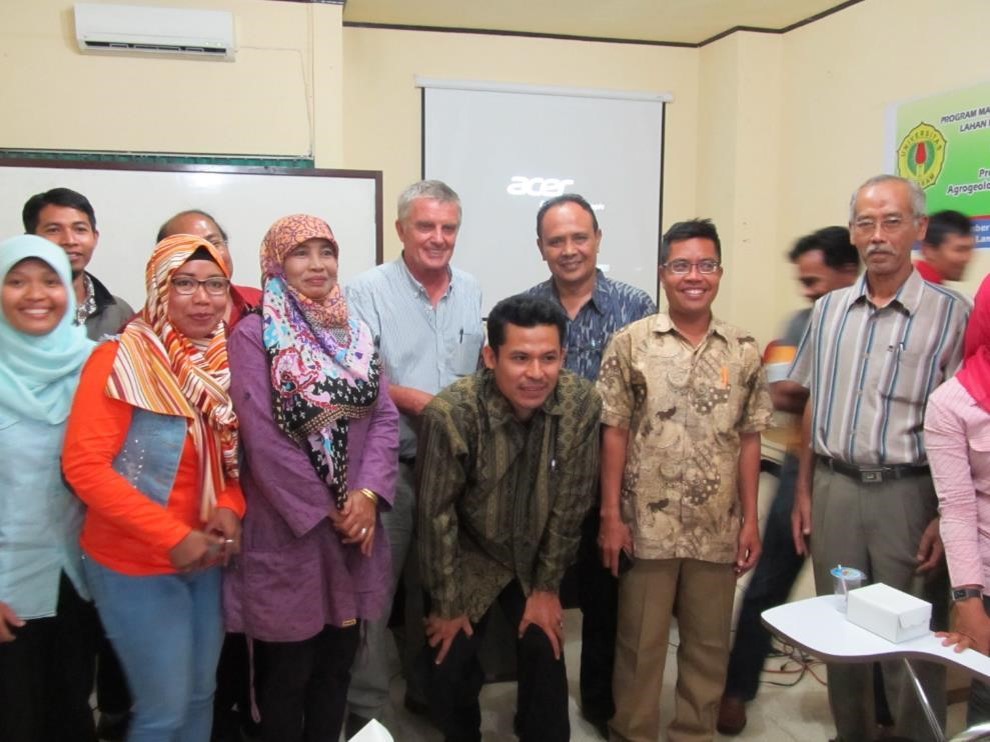
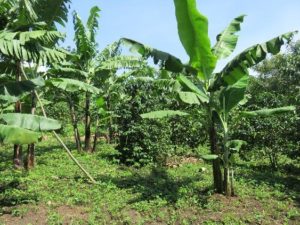
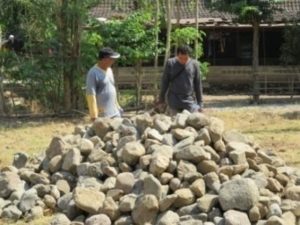
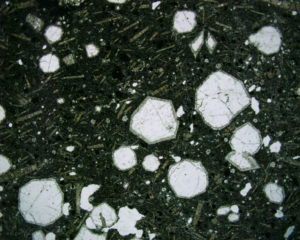
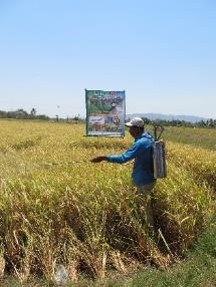
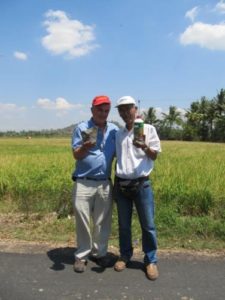
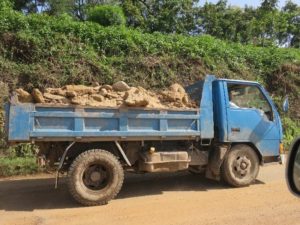
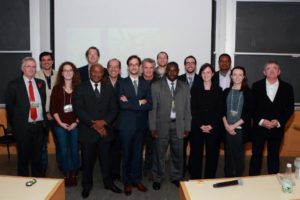
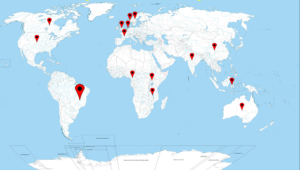






Got something to say?